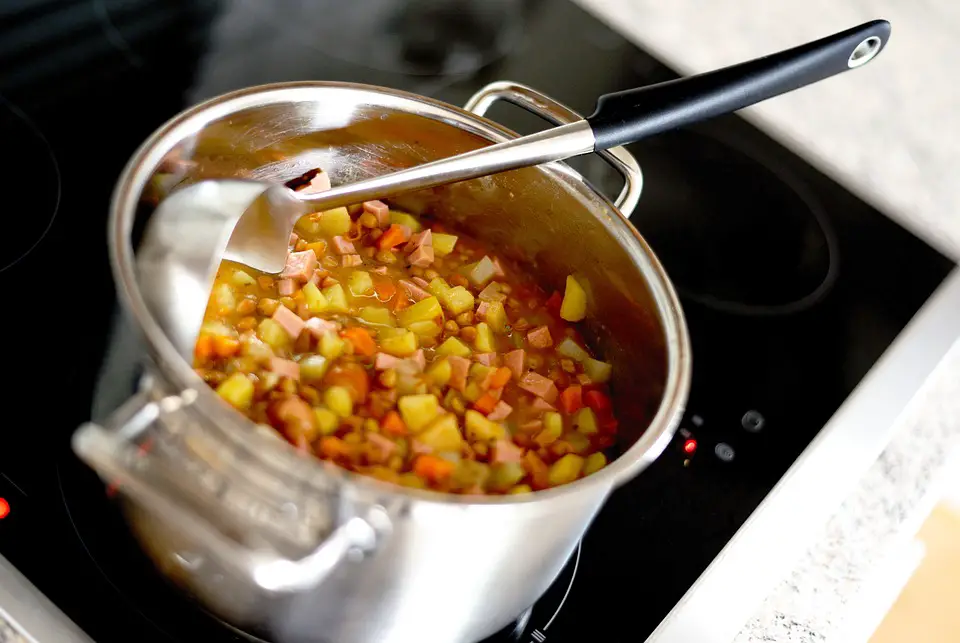If you are looking for ways to reheat frozen soup, this article will give you some tips on reheating soup without the hassle of thawing it in the microwave. Listed below are the best options for reheating your favorite soup without the hassle of thawing it first. If you can’t wait that long, you can also try Souper Cubes, a slow cooker, and even glass mason jars. These options will save you time and money.

To guarantee that soup is thoroughly heated and all bacteria have been eliminated, ensure it is hot throughout, not just in a few hot spots. The consistency or taste may not be as nice as freshly produced, so keep in mind that quality declines every time it is reheated.
How should I Reheat Frozen Soup?
- Remove the soup block from the freezer, and store it in the refrigerator for up to two days.
- In a clean saucepan or pan, empty the contents of the soup bag, and cook, frequently stirring to distribute the heat on medium heat.
- The soup should start to bubble in no time. And water or broth until the required consistency is achieved.
- To revive soup when the original flavor has worn off, lightly reseason it and add fresh herbs.
- Using a food thermometer, cook soup until the temperature reads 165F or above halfway through.
Guidelines for Microwave Frozen Soup Reheating
The microwave makes it simple and quick to reheat the frozen soup. There are some helpful tips to keep the consistency and flavor as fresh as possible while using a microwave.
Here are some helpful hints for microwave soup rewarming from frozen:
- For microwave-safe symbols, look. Glass and ceramic bowls can typically be microwaved. Metal bowls should never be heated in the microwave, though. When heated in a microwave, plastic tends to leak dangerous chemicals into food, raising the risk of many different ailments.
- To reheat frozen soups, use a microwave-safe mug or soup bowl. The usage of Glass or ceramic dishware in the microwave is generally advised.
- Even though it’s the microwave’s default setting, avoid utilizing the highest power level. The least reliable outcomes are produced by high heat, which is unnecessary.
- The frozen soup will defrost evenly on low power. To alter the power level or to thaw frozen soup before reheating, always enter the cooking time first and then hit the power button.
- Utilizing oven mitts or heat-resistant gloves, carefully remove the bowl from the microwave. The bowl will be very hot.
- To prevent any harm when stirring steaming hot broth, stir frequently and use a wooden spoon rather than a metal spoon. When defrosting, stir to break up any large pieces of frozen soup; after that, stir to disperse heat throughout the previously frozen soup.
How Long should you Microwave-Reheat Frozen Soup?
The typical time to fully thaw frozen soup is 2 to 3 minutes. Then the soup must be fully reheated for 2 to 3 minutes on high to reach a safe internal temperature of 74 degrees Celsius or 165 degrees Fahrenheit.
It takes longer to reheat frozen soup in the microwave. Depending on the volume of frozen soup and the power of the microwave, this reheating time may change. The more soup there is and the lower the appliance wattage.
Soup can be heated directly from frozen, although it works best after being microwaved to defrost.
Put the frozen soup in a bowl that can be microwaved. A lid, wet paper towel, or plastic wrap used to cover the container partially should be microwaved at low power for two to three minutes.
Repeat the practice of thoroughly stirring every minute until the soup becomes mushy.
Defrost before reheating for the greatest results, regardless of whether the soup is made with broth or noodles. Can Frozen Soup be Reheated Twice?
Reheating frozen soup more than once is not advised. This is because the more you freeze and reheat the soup, the greater the chance that bacteria will grow and perhaps cause food poisoning.
To get the greatest flavor, it would be ideal for eating soup immediately after reheating it. If the food is not handled safely, reheating food twice could increase the danger of food illness.
According to standard recommendations for food safety, soup can be safely reheated as long as the temperature is reached. The food regulations, however, advise against reheating any soup that contains meat more than once.
To guarantee that soup is thoroughly heated and all bacteria have been eliminated, ensure it is hot throughout, not just in a few hot spots. The consistency or taste may not be as nice as freshly produced, so keep in mind that quality declines every time it is reheated.
Using a Slow Cooker to Reheat Frozen Soup
Using a slow cooker to reheat your frozen soup is easy. Before putting the ingredients into the pot, defrost them first. Depending on the soup, this can be as quick as a few minutes or as long as half an hour. Once the ingredients are prepared, pour them into the slow cooker and set them to low heat for 10 to 15 minutes. Stir the soup occasionally so that the ingredients are evenly distributed. During this time, reduce the amount of liquid if necessary, and then remove the pot from the heat. Once the soup is finished, store it in an airtight container in the refrigerator or the freezer, which will keep for several days.
Vegetables should be added toward the end of the cooking time. Root vegetables, such as carrots, potatoes, beets, and radishes, need longer cooking time than other vegetables. Soft vegetables, such as corn, should be added near the end. They may become too soft and fall apart if you add them earlier. Also, meats should be added toward the end of the cooking time.
Using Souper Cubes to Reheat Frozen Soup
If you like to eat various foods, you can easily store leftovers in ice cube trays with Souper Cubes. These containers are like big ice cube trays; you can freeze single servings of your favorite soup. These containers can be removed from the silicone compartment when frozen. The best part is that you don’t have to worry about your leftovers going bad, and you don’t have to worry about thawing.
Freezing soup in a traditional container can become too large to store at home and take up freezer space. Afterward, the soup may get contaminated by oxygen, resulting in a terrible taste. Because of this, you are using a soup container with an airtight lid is a good idea. This way, you can reheat frozen soup without worrying about freezer burn. Moreover, you can easily reheat leftover soup when you need to. Souper Cubes come in various sizes, so you can use one that fits your needs.
Can Frozen Soup be Reheated Twice?
Reheating frozen soup more than once is not advised. This is because the more you freeze and reheat the soup, the greater the chance that bacteria will grow and perhaps cause food poisoning.
Eating tiny soup immediately after reheating would be ideal for getting the greatest flavor. If the food is not handled safely, reheating food twice could increase the danger of food illness.
According to standard recommendations for food safety, soup can be safely reheated as long as the temperature is reached. The food regulations, however, advise against reheating any soup that contains meat more than once.
To guarantee that soup is thoroughly heated and all bacteria have been eliminated, ensure it is hot throughout, not just in a few hot spots. The consistency or taste may not be as nice as freshly produced, so keep in mind that quality declines every time it is reheated.
Can Soup be Freezed After Three Days?
No, there might be some bacterial growth in the soup.
Place the soup in the refrigerator until it has cooled. To avoid wasting time defrosting the entire amount, it is best to rapidly divide the precise portion of the meal that you will need later. Place the soup in airtight containers or Ziploc bags.
Can you Freeze Cream-Infused Soup?
No, cream-based soups cannot be frozen.
Before freezing the soup, milk ingredients and preservatives should be filtered off.
If you have any soup left over from lunch, remove the cream and freeze it. Future warming is made easier and more accessible by separating the cream from the soup. The soup can be repackaged in the appropriate bags or containers.
Conclusion
A delicious and nourishing meal prep can be heated up and enjoyed whenever it is frozen soup. Additionally, leftover soups can be frozen and prepared quickly for later consumption.
It can be challenging to reheat frozen soup quickly, but you can safely reheat any soup in the microwave to bring back the flavor and taste. If at all possible, avoid reheating soup more than once. Harmful bacteria are prone to grow when food is stored, refrigerated, then reheated.
If you have soup leftovers from a large batch, it is safer to freeze and reheat individual servings than the entire pot. Please choose the desired serving size of frozen soup, place it in a soup bowl suitable for the microwave, and loosely cover it with a lid.
Set the microwave on defrost power or 30% low heat for two minutes. After the breaks, break up any bits of ice, mix well, and keep thawing the soup until it is mushy and at room temperature. The amount of frozen soup being defrosted will determine whether it takes less than 2 minutes.

